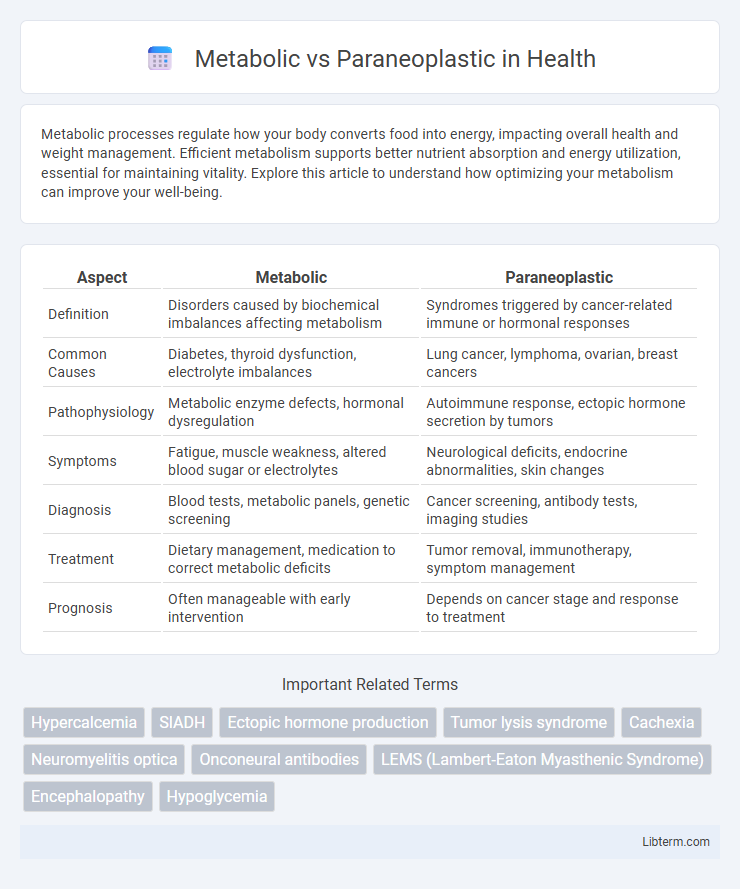Metabolic processes regulate how your body converts food into energy, impacting overall health and weight management. Efficient metabolism supports better nutrient absorption and energy utilization, essential for maintaining vitality. Explore this article to understand how optimizing your metabolism can improve your well-being.
Table of Comparison
| Aspect | Metabolic | Paraneoplastic |
|---|---|---|
| Definition | Disorders caused by biochemical imbalances affecting metabolism | Syndromes triggered by cancer-related immune or hormonal responses |
| Common Causes | Diabetes, thyroid dysfunction, electrolyte imbalances | Lung cancer, lymphoma, ovarian, breast cancers |
| Pathophysiology | Metabolic enzyme defects, hormonal dysregulation | Autoimmune response, ectopic hormone secretion by tumors |
| Symptoms | Fatigue, muscle weakness, altered blood sugar or electrolytes | Neurological deficits, endocrine abnormalities, skin changes |
| Diagnosis | Blood tests, metabolic panels, genetic screening | Cancer screening, antibody tests, imaging studies |
| Treatment | Dietary management, medication to correct metabolic deficits | Tumor removal, immunotherapy, symptom management |
| Prognosis | Often manageable with early intervention | Depends on cancer stage and response to treatment |
Understanding Metabolic Disorders
Metabolic disorders result from disruptions in the body's biochemical processes, often due to enzyme deficiencies or hormonal imbalances affecting metabolism. These conditions can lead to abnormal accumulation or deficiency of metabolites, impacting energy production and organ function. Understanding metabolic disorders is crucial in differentiating them from paraneoplastic syndromes, which arise from cancer-related immune responses rather than intrinsic metabolic defects.
What Are Paraneoplastic Syndromes?
Paraneoplastic syndromes are a group of disorders triggered by an abnormal immune response to a neoplasm, often cancer, which produces substances disrupting normal metabolism and organ function. These syndromes are distinct from metabolic disorders caused by direct tumor invasion or metastasis since they arise remotely from the tumor site through immune-mediated or hormone-like effects. Common manifestations include neurological, endocrine, dermatologic, and hematologic symptoms, which serve as crucial diagnostic markers in oncology.
Key Differences: Metabolic vs Paraneoplastic Conditions
Metabolic conditions arise from biochemical disruptions affecting cellular functions, often linked to enzyme deficiencies or hormonal imbalances, resulting in symptoms like fatigue, weight changes, and electrolyte disturbances. Paraneoplastic conditions emerge as indirect effects of malignancies, where tumors produce hormones or immune responses that cause systemic symptoms such as neuropathy, cachexia, or endocrine abnormalities. Key differences include the origin of dysfunction--metabolic disorders stem from intrinsic metabolic pathway errors, while paraneoplastic syndromes are triggered by cancerous tumors outside the primary site.
Common Causes of Metabolic Imbalances
Common causes of metabolic imbalances include diabetes mellitus, hypothyroidism, renal failure, and electrolyte disturbances such as hypercalcemia or hyponatremia. In contrast, paraneoplastic syndromes arise from ectopic hormone production or immune-mediated responses caused by malignancies like small cell lung cancer or renal cell carcinoma. Understanding the distinct etiologies aids in accurate diagnosis and targeted treatment of metabolic versus paraneoplastic disorders.
Tumor-Related Mechanisms in Paraneoplastic Syndromes
Paraneoplastic syndromes arise from tumor-related mechanisms where malignant cells produce hormones, peptides, or cytokines that disrupt normal metabolic processes. Unlike metabolic disorders caused by intrinsic organ dysfunction, paraneoplastic metabolic disturbances result from ectopic secretion of active substances by tumors. These tumor-derived factors lead to complex systemic effects including hypercalcemia, hypoglycemia, or electrolyte imbalance, highlighting the critical role of neoplastic activity in metabolic dysregulation.
Clinical Manifestations: Metabolic vs Paraneoplastic
Metabolic disorders typically present with clinical manifestations such as muscle weakness, fatigue, and electrolyte imbalances including hypokalemia or hypercalcemia, reflecting underlying biochemical disruptions. Paraneoplastic syndromes exhibit a broader spectrum of symptoms including neurological deficits, dermatological changes, and endocrine abnormalities unrelated to direct tumor invasion but caused by immune responses or ectopic hormone production. Differentiation depends on specific biomarkers and clinical context, where metabolic symptoms arise from systemic metabolic imbalances and paraneoplastic symptoms result from immune-mediated or hormonal effects of malignancies.
Diagnostic Approaches to Metabolic and Paraneoplastic Disorders
Diagnostic approaches to metabolic disorders emphasize biochemical assays such as serum enzyme levels, metabolite quantification, and genetic testing to identify enzyme deficiencies or metabolic pathway disruptions. In contrast, paraneoplastic disorders require oncological evaluation including imaging modalities like CT, PET scans, and detection of onconeural antibodies to establish the presence of underlying malignancies triggering immune-mediated symptoms. Combining metabolic panels with tumor marker assessments enhances differential diagnosis and guides targeted treatment strategies effectively.
Treatment Strategies: Metabolic vs Paraneoplastic Management
Metabolic treatment strategies primarily focus on correcting biochemical imbalances through nutrient supplementation, hormone replacement, or enzyme therapy, aiming to restore metabolic homeostasis. Paraneoplastic management involves addressing the underlying malignancy with chemotherapy, immunotherapy, or radiation, alongside symptomatic treatment to counteract immune-mediated effects. Both approaches require targeted diagnostic evaluation to tailor interventions for the specific metabolic disturbances or paraneoplastic syndromes present.
Prognostic Implications and Outcomes
Metabolic disorders often present with reversible abnormalities and typically have a better prognosis when the underlying cause is identified and treated promptly. Paraneoplastic syndromes are associated with malignancies and generally indicate a more severe prognosis due to the systemic effects of the tumor and potential cancer progression. Prognostic outcomes for paraneoplastic conditions are largely dependent on the effective management of the primary cancer and the resolution of paraneoplastic symptoms.
Future Directions in Research and Therapy
Future research on metabolic and paraneoplastic syndromes is exploring targeted molecular therapies that address specific metabolic pathways and immune responses involved in tumor-induced conditions. Advances in genomics and proteomics are enabling personalized treatment strategies, improving diagnostic accuracy and therapeutic efficacy for paraneoplastic manifestations. Integration of immunotherapy with metabolic modulators holds promise for evolving treatment paradigms and enhancing patient outcomes.
Metabolic Infographic

 libterm.com
libterm.com